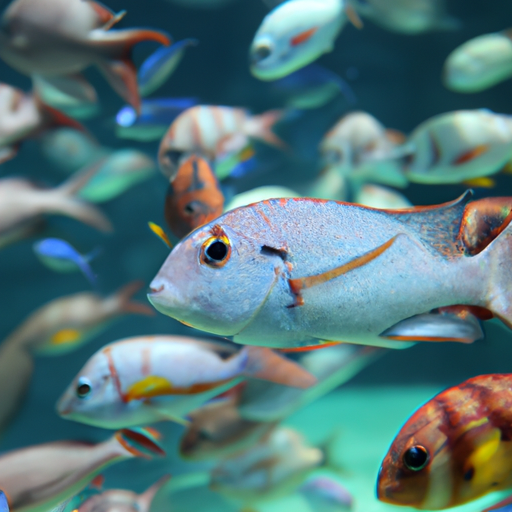Are you fascinated by the vast variety of fish species but find it challenging to identify them? Look no further than “The Beginner’s Guide To Identifying Fish Species.” This comprehensive guide is designed specifically for beginners like you who want to learn the art of fish identification. Whether you’re an avid angler, a curious marine enthusiast, or just someone who enjoys observing underwater life, this guide will equip you with the knowledge and skills to confidently recognize and classify different fish species. With clear illustrations, detailed descriptions, and helpful tips, this guide is your go-to resource for unraveling the mysteries of the aquatic world.
Understanding Fish Species
Definition of Fish Species
When it comes to understanding fish species, it is important to start with a clear definition. A fish species refers to a distinct group of fish that share common characteristics and can breed with one another to produce fertile offspring. These characteristics can include physical features, such as body shape, fin configuration, and coloration, as well as behavioral traits and habitat preferences. By identifying different fish species, we gain a better understanding of the diversity and complexity of aquatic ecosystems.
Importance of Identifying Fish Species
Identifying fish species is not just an activity for avid anglers or marine biologists. It is a valuable skill that can benefit anyone with an interest in the underwater world. Knowing how to identify different fish species allows us to appreciate the natural beauty and diversity of aquatic environments. It also helps in understanding the ecological roles that different fish species play in their ecosystems, such as their feeding habits, reproductive behavior, and interactions with other species.
Visual Observation
External Features
One of the key ways to identify fish species is through careful observation of their external features. These features can include the shape and size of the fish’s body, the arrangement of its fins, the presence of any specialized structures (such as barbels or spines), and even its scales or skin texture. By paying attention to these external features, you can start to narrow down the possibilities and make more accurate identifications.
Coloration and Patterns
Coloration and patterns are another important visual characteristic to consider when identifying fish species. Some fish may have vibrant and distinct coloration, while others might rely on patterns or markings to differentiate themselves. These colorations and patterns can serve various purposes, such as camouflage, species recognition, or even communication within the group. By taking note of these visual cues, you can further refine your identification skills.
Fin Configuration
The configuration of a fish’s fins can also provide crucial information for identifying its species. Fins can come in a variety of shapes, sizes, and positions along the fish’s body. The presence or absence of certain fins, as well as the number and placement of rays or spines, can be unique to specific fish species. Paying attention to fin configuration can be particularly useful when trying to distinguish between closely related species.

Habitat and Behavior
Water Environment
Understanding a fish’s habitat is essential for accurate species identification. Fish species often display preferences for specific water environments, such as freshwater rivers, saltwater oceans, or even brackish estuaries. Additionally, some species may have further specific habitat requirements, such as shallow coastal zones, deep open waters, or specific types of substrate. By considering the water environment in which a fish is found, you can narrow down the possibilities and improve the accuracy of your identification.
Feeding Habits
A fish’s feeding habits can provide valuable clues about its species. Different species have evolved various feeding strategies to exploit their environment and acquire food. Some fish are herbivorous, feeding primarily on plants and algae, while others are carnivorous and consume other fish or invertebrates. Certain species may also have specialized feeding adaptations, such as long beaks for hunting prey in crevices or suction mouths for filter-feeding. Understanding a fish’s feeding habits can help you differentiate between species with similar appearances.
Reproduction Behavior
Reproduction behavior can also be an important factor in identifying fish species. Fish species often have specific mating rituals, spawning behaviors, and parental care strategies. Some species may perform elaborate courtship displays or build intricate nests, while others may exhibit aggressive territorial behaviors. By observing and understanding these reproductive behaviors, you can gain insights into a fish’s species and better appreciate the complexities of their life cycle.
Resources for Identifying Fish
Field Guides
Field guides are an invaluable resource for identifying fish species. These guides often contain detailed descriptions and illustrations of different species, along with information about their distribution, habitat preferences, behavior, and more. Field guides can be specific to a particular region or cover a broader geographic area, making them useful for both local identification and when exploring new locations. It is important to choose field guides that are up-to-date and reputable, as fish taxonomy and scientific research can evolve over time.
Online Databases
In today’s digital age, online databases have become a popular tool for identifying fish species. These databases often include comprehensive collections of photographs, species profiles, distribution maps, and even interactive identification keys. Online databases can be particularly helpful when you encounter a fish species that is unfamiliar or rare in your local area. However, it is important to verify the credibility and accuracy of the information provided, as not all online sources are equally reliable.
Local Experts
When in doubt, seeking guidance from local experts can be invaluable for identifying fish species accurately. Local experts can include professional marine biologists, ichthyologists, or experienced anglers who have in-depth knowledge of the fish species in a specific area. They can provide firsthand insights, share their expertise, and even accompany you on field trips to better identify fish in their natural habitats. Engaging with local experts is not only educational but also helps foster a sense of community and passion for conserving aquatic ecosystems.

Common Fish Families
Perciformes
The Perciformes order is the largest and most diverse group of fish, containing over 10,000 species. This order includes popular game fish such as bass, snapper, and grouper, as well as various reef fish and many economically important species. Perciformes can be identified by their spiny fins, sharp teeth, and streamlined bodies. However, within this diverse order, there is a wide range of shapes, sizes, and colorations, making species identification within the group a fascinating and challenging endeavor.
Cypriniformes
Cypriniformes is another significant order of fish that includes familiar species such as carp, minnows, and goldfish. These fish are typically characterized by their small, scaleless bodies, and large eyes. Many Cypriniformes species are found in freshwater environments and exhibit various feeding strategies, including herbivory, omnivory, and opportunistic feeding. Identifying Cypriniformes species often requires attention to subtle differences in morphological traits and behavior.
Siluriformes
Siluriformes, commonly known as catfish, are a distinct order of fish known for their barbels or “whiskers.” These barbels, located near the mouth, are used for sensory purposes and help catfish locate food in dark or murky waters. Siluriformes come in a wide range of sizes and can be found in both freshwater and saltwater environments. Identifying catfish species often involves observing their barbel arrangement, body shape, and fin configurations.
Identifying Freshwater Species
Anatomy Features
When it comes to identifying freshwater fish species, paying attention to specific anatomical features can be crucial. These features include the shape and placement of the mouth, the position of the eyes, the number and arrangement of fins, and the presence of any specialized structures such as barbels or spines. By carefully examining these anatomical details, you can begin to differentiate between various freshwater species and build your identification skills.
Key Characteristics
Key characteristics for identifying freshwater fish species can vary depending on the specific group or family. For example, some species may have distinctive coloration patterns, such as the vibrant stripes of a tiger barb or the bright red tail of a male betta fish. Others may have unique body shapes, such as the elongated body of a pike or the laterally compressed body of a sunfish. Understanding these key characteristics and being able to recognize them will greatly enhance your ability to identify freshwater fish species accurately.

Identifying Saltwater Species
Adaptations to Saltwater
Saltwater fish species have evolved various adaptations to thrive in the ocean’s challenging environment. These adaptations can provide valuable clues for identification. Some saltwater species, such as clownfish, have bold coloration that helps them blend in with coral reefs. Others, like flounders, have a flattened body shape that allows them to camouflage on the ocean floor. Paying attention to these adaptations can greatly assist in identifying saltwater fish species accurately.
Key Characteristics
Similar to freshwater species, saltwater fish also have key characteristics that can aid in identification. These characteristics may include distinct markings or color patterns, such as the dark bars seen on a zebra moray eel or the spots on a leopard shark. Specialized appendages, such as the elongated bill of a swordfish or the enlarged dorsal fin of a sailfish, can also be important identifying features. By familiarizing yourself with these key characteristics, you can become more proficient at identifying saltwater fish species.
Difficult-to-Identify Species
Cryptic Species
Cryptic species are those that are visually very similar or virtually indistinguishable, making identification challenging even for experts. These species often have subtle differences in their genetic makeup or internal structures, resulting in limited external variation. Cryptic species can be found in both freshwater and saltwater environments, and their existence highlights the need for molecular techniques and advanced tools to accurately distinguish them.
Hybrid Species
Hybrid species, as the name suggests, are the result of interbreeding between two different fish species. These hybrids may display a mix of characteristics from both parent species, making identification confusing. Hybridization can occur naturally, but it is also often facilitated by human activities such as stock enhancement or accidental release of non-native species. When encountering a fish that shows traits of more than one species, it is essential to consider the possibility of hybridization.

Conservation Concerns
Threatened and Endangered Species
Identifying and understanding fish species is not just about their aesthetics; it also plays a crucial role in conservation efforts. Many fish species, both freshwater and saltwater, face threats such as habitat loss, pollution, overfishing, and climate change. The ability to identify and track populations of threatened or endangered species is essential for implementing effective conservation strategies. Identifying these species accurately allows scientists and conservationists to focus their efforts on protecting and restoring their habitats.
Invasive Species
Invasive species pose a significant threat to native fish populations and ecosystems. These non-native species often outcompete native species for resources and disrupt the delicate balance of aquatic ecosystems. Proper identification of invasive species is crucial for early detection and prevention of their spread. By being able to recognize invasive species and reporting their presence, individuals can play a vital role in helping to manage and mitigate their impacts on native fish communities.
Ethical Considerations
Catch and Release Practices
Responsible fishing practices and ethical considerations go hand in hand with identifying fish species. Catch and release practices involve carefully handling and releasing fish back into the water unharmed after capturing them for sport or research purposes. Proper identification ensures that only the targeted species or those within legal limits are retained, while others are released promptly. This practice helps sustain fish populations, promotes conservation, and ensures the enjoyment of angling for generations to come.
Responsible Fishing
Identifying fish species also contributes to responsible and sustainable fishing practices. Understanding the life history and behavior of the species you are targeting allows for informed decisions on gear selection, fishing techniques, and appropriate locations. Additionally, identifying the different species present in an area can help avoid unintentional bycatch of non-targeted or protected species. Responsible fishing practices minimize the ecological impact, promote sustainable fisheries, and maintain the overall health of aquatic ecosystems.
In conclusion, understanding fish species is a fascinating journey that opens up a world of underwater exploration and appreciation. By observing and learning about external features, coloration, fin configuration, habitat, behavior, and more, you can develop the skills to identify different fish species accurately. Field guides, online databases, and local experts are valuable resources that can assist you in your identification endeavors. By recognizing common fish families, identifying freshwater and saltwater species, and understanding challenging-to-identify species such as cryptic and hybrid species, you can deepen your knowledge and appreciation for the diverse world of fish. Furthermore, recognizing the conservation concerns surrounding threatened and endangered species, as well as invasive species, and embracing ethical considerations such as catch and release practices and responsible fishing, allows us to become stewards of aquatic ecosystems and promote their preservation for future generations. So dive in, explore, and enjoy the fascinating world of fish species identification!






